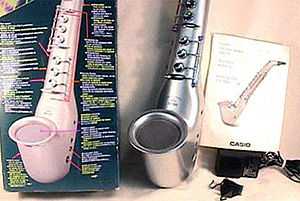Zanzithophone

The zanzithophone is a name given to an electronic MIDI digital wind controller/synthesizer. It is also proper to refer to it as "Digital Horn" as can be seen printed on the instrument itself. It was produced by Casio in the mid 1980's as the DH-100 (silver) or DH-200 (black). A later model, DH-280, was the same basic instrument with an added "accompaniment module'; this module was carried into the DH-800: a cartridge insert provided four pre-recorded songs: When the Saints go Marching In,Air on the (sic) G String,Chopin's Nocturne, and I Lost the DOH in my Clarinet, each of which could be played with or without melody. The module also provided sixteen standard rhythms.
Each model has six built in synthesized sounds; saxophone, trumpet, synth-reed, oboe, clarinet, and flute; the tones produced are audibly more electronic than the tones of the real instruments named. They look like a clarinet/saxophone hybrid. They can be played with recorder fingering over a two-octave range, or with the "Casio system" (similar to standard brass instrument fingering) which allows for up to 4 octaves to be played. A transpose button permits the player to change to any chromatic key over a two-octave range. The DH-280 also had a tuning button. A key near the top of the instrument allows a portamento-like slide between notes. Finally, a switch permitted the instrument to be played without blowing through it, making the keys operate like a digital keyboard.
These instruments were breath-sensitive for volume. Unlike other digital wind controllers, the breath actually flows through the instrument, making it feel similar to an acoustic woodwind instrument. Each came with a small built-in speaker, and also had an output cable for external amplification. MIDI OUT capability of the instrument means that it can be used to control sounds from other MIDI synthesizers that offered a MIDI IN connection. These features, and its low price (it was initially marketed as a toy) increased its appeal to budget-minded musicians.
Power for the instruments came from five AA batteries, with provision for connecting an aftermarket 7.5 volt AC adaptor.
The instruments are prone to developing a squeal. This is because of a capacitor deteriorating; it can be fixed by replacing the capacitor. None of the instruments had a read-out display of any type, so transposing, changing tone, and other functions generally required counting button-clicks.
This instrument was most notably used by The Elephant 6 Recording Company based in Athens, Georgia and by Was (Not Was) in live performance of I Feel Better than James Brown
References in literature
The zanzithophone is mentioned in a footnote on page 66 of Kim Cooper's book In the Aeroplane Over the Sea (New York: Continuum, 2005).
External links
- Web site with instructions for squeal fix and other fixes for the Casio Digital Horn
- Fingering chart and link to manual, MIDI implementation chart, more
- Was (Not Was) performing with DH-200
- site for Ted Keys, a professional musician who plays these instruments
- general information on digital wind midi conrollers, including Casio
| |||||||||||||||||||||||||||||||||||||||||
